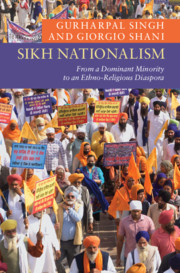Book contents
- Sikh Nationalism
- New Approaches to Asian History
- Sikh Nationalism
- Copyright page
- Contents
- Maps
- Figures
- Tables
- Acknowledgements
- Abbreviations
- Glossary
- Introduction
- 1 Understanding Sikh Nationalism
- 2 Sikhism and the Sikhs up to the 1890s
- 3 The Emergence of Modern Sikh Nationalism, 1880s–1930s
- 4 The Partition of India and the Sikhs, 1940–1947
- 5 The Indian Union and the Sikhs, 1947–1984
- 6 Militancy, Antiterrorism and the Khalistan Movement, 1984–1997
- 7 Sikh Nationalism in the Age of Globalisation and Hindutva, 1997 to the Present
- 8 The Diaspora
- Conclusion
- Timeline
- Appendix: Anandpur Sahib Resolution
- References
- Index
- New Approaches to Asian History
3 - The Emergence of Modern Sikh Nationalism, 1880s–1930s
Published online by Cambridge University Press: 19 November 2021
- Sikh Nationalism
- New Approaches to Asian History
- Sikh Nationalism
- Copyright page
- Contents
- Maps
- Figures
- Tables
- Acknowledgements
- Abbreviations
- Glossary
- Introduction
- 1 Understanding Sikh Nationalism
- 2 Sikhism and the Sikhs up to the 1890s
- 3 The Emergence of Modern Sikh Nationalism, 1880s–1930s
- 4 The Partition of India and the Sikhs, 1940–1947
- 5 The Indian Union and the Sikhs, 1947–1984
- 6 Militancy, Antiterrorism and the Khalistan Movement, 1984–1997
- 7 Sikh Nationalism in the Age of Globalisation and Hindutva, 1997 to the Present
- 8 The Diaspora
- Conclusion
- Timeline
- Appendix: Anandpur Sahib Resolution
- References
- Index
- New Approaches to Asian History
Summary
This chapter examines the emergence of modern Sikh nationalism against the background of colonial modernisation of the Punjab’s economy from the last quarter of the nineteenth century. It reviews the competitive social mobilisation that led to religious reform movements among Hindus, Muslims and Sikhs. It examines the role of the Singh Sabhas in the late nineteenth century that were at the forefront of the religious renaissance among the Sikhs, shaping a distinct non-Hindu identity which culminated with the Akali movement in the early 1920s and the Sikh Gurdwaras Act (1925). It then reviews the cultural expressions of this new consciousness in the growth of the Punjabi press, Punjabi language, literature and material culture. This is followed by an outline of the dominant narratives of Sikh politics during colonial democratisation that ended with the Government of India Act (1935) and its immediate aftermath before the outbreak of the Second World War. The conclusion summarises the internal cleavages within Sikh society dating from this period that underlay the overarching sense of Sikh identity and continue to provide competing conceptions of Sikh identity and the nationalist ideal.
- Type
- Chapter
- Information
- Sikh Nationalism , pp. 52 - 81Publisher: Cambridge University PressPrint publication year: 2021

